Baltimore Oriole Icterus galbula.
Image appears here with the kind permission of the photographer, Pamela Wells.
Birds in Science
People have long wondered how cowbirds can get away with leaving their eggs in the nests of other species, who then raise the baby cowbirds. Why don't the hosts just toss the strange eggs out? Now researchers seem to have an answer -- if the host birds reject the strange eggs, the cowbirds come back and trash the place. "It's the female cowbirds who are running the mafia racket at our study site," Jeffrey P. Hoover, of the Florida Museum of Natural History and the Illinois Natural History Survey, said in a statement. "Our study shows many of them returned and ransacked the nest when we removed the parasitic egg," he explained.
U.S. ecologists are offering an explanation as to why some birds migrate long distances each year, while other bird species never travel at all. One textbook explanation suggests eating fruit or living in non-forested environments were factors that evolved migratory behavior. But W. Alice Boyle and Courtney Conway of the University of Arizona disagree, saying the pressure to migrate comes from seasonal food scarcity. "It's not just whether you eat insects, fruit, or candy bars, or where you eat them -- it matters how reliable that food source is from day-to-day," Boyle said. "For example, some really long-distance migrants like Arctic Terns are not fruit-eaters."
People Hurting Birds
The population of endangered vultures continues to decline, as diclofenac -- a veterinary painkiller -- continues to inundate the market, taking a steady toll on them. Conservationists cry foul over the continued production of diclofenac in Nepal, despite a "ban" on the drug since June, 2006. Astonishingly, the assinine drug manufacturers stupidly assert that the government has not ordered them to refrain from production with the raw material already in stock. "Continued production of the drug by Nepal's two drug manufacturers and its smuggling through the porous Nepal-India border have pushed the vulture to the brink of extinction," says Hem Sagar Baral, an ornithologist, who is also executive chief at Bird Conservation Nepal (BCN). GrrlScientist comment: Are these people so blinded by greed that they are willing to cause this impending environmental disaster that will affect the entire continent, including themselves? They are as short-sighted and as moronic as American CEOs!
Fancy a pet jaguar cub? How about a rare parrot? The trade in wild animals in Mexico threatens some of the world's most exotic endangered species. At the Sonora Market, a bustling bazaar, traders illegally sell animals alongside exotic herbs and folk cures in the heart of Mexico City's often lawless center. "It would take an army to stop this," whispered conservationist Juan Carlos Cantu as he edged his way through the stalls. A policeman seemingly unconcerned at the illegal sales stood just steps away.
 Thousands of birds that died in Western Australia in the space of a month may have been victims of lead poisoning, testing has determined. WA's Department of Environment and Conservation (DEC) has until now been unable to determine what killed up to 4000 nectar-eating birds in and around Esperance between December 7 and January 2. The birds, mostly yellow-throated miners, Manorina flavigula; wattle birds, Anthochaera chrysoptera; New Holland honeyeaters, Phylidonyris novaehollandiae; and silvereyes, Zosterops lateralis, plus some seagulls and pigeons, were found dead near water sources such as sprinklers and water tanks. More than 100 further bird deaths have been reported in Esperance this week, mostly of purple-crowned lorikeets, Glossopsitta porphyrocephala (pictured).
Thousands of birds that died in Western Australia in the space of a month may have been victims of lead poisoning, testing has determined. WA's Department of Environment and Conservation (DEC) has until now been unable to determine what killed up to 4000 nectar-eating birds in and around Esperance between December 7 and January 2. The birds, mostly yellow-throated miners, Manorina flavigula; wattle birds, Anthochaera chrysoptera; New Holland honeyeaters, Phylidonyris novaehollandiae; and silvereyes, Zosterops lateralis, plus some seagulls and pigeons, were found dead near water sources such as sprinklers and water tanks. More than 100 further bird deaths have been reported in Esperance this week, mostly of purple-crowned lorikeets, Glossopsitta porphyrocephala (pictured).
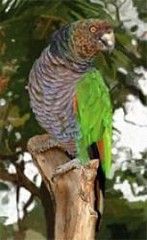 A German national is due to return to a Dominican court, charged with killing a Sisserou Parrot, Amazona imperialis (pictured), one of the island's endangered national birds. Police said Michael Fray had been released on US$1,800 bail after he was arrested on a charge of killing an endangered species.
A German national is due to return to a Dominican court, charged with killing a Sisserou Parrot, Amazona imperialis (pictured), one of the island's endangered national birds. Police said Michael Fray had been released on US$1,800 bail after he was arrested on a charge of killing an endangered species.
The harsh reality is that the majority of pets that are released in the wild will die. Some will die quickly, possibly after getting hit by a vehicle or running into a predator. Others will die a long, slow death by starvation. Either way, it is extremely cruel to release a pet into the wild. This article discusses how many exotic pets are more domesticated than they are wild and do not have the skills to survive. Even those that were originally caught in the wild still have a difficult time adapting to a new environment, where their usual food source is not available or the climactic conditions may not be suitable, such as the temperature, humidity, availability of water or hiding places.
People Helping Birds
Thanks to Birdlife's efforts, the plight of the world's seabirds was a key agenda item at the week-long meeting of the UN's Food and Agriculture Organization (FAO) Committee on Fisheries. Of the 21 albatross species, nineteen are threatened with extinction. Seabird bycatch in longline fisheries, where seabirds swallow baited hooks and drown, is a major threat to many of these species. At the meeting, the FAO announced their support for a consultation of Member states that will become the first step toward definitive 'best-practice guidelines' for reducing seabird bycatch and halting the decline of many albatross and petrel populations.
Firefighters are battling to protect a roosting site for rare birds that are due to arrive on Tasmania's King Island. Salt water is being pumped to an area surrounding a bush fire where orange-bellied parrots, Neophema chrysogaster, stop for rest and food on their interstate migration from Tasmania. "We have laid about one kilometre of hose and are using salt water to protect their habitat," Tasmania Fire Services operations officer Paul Hill said. "A remote area crew has also carried out controlled burns surrounding the site."
Rare Birds
More elusive than even the Ivory-billed woodpecker, a large-billed reed-warbler, Acrocephalus orinus, has been rediscovered at a wastewater treatment plant outside of Bangkok, Thailand, Birdlife International announced recently. The bird has eluded birders and ornithologists for more than 130 years.
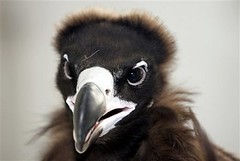 A rare cinereous vulture, Aegypius monachus (pictured), from Mongolia got lost and flew to Thailand. This bird has been nursed back to health by veterinarians at Kasetsart University in Bangkok, after apparently getting lost in late December and ending up dehydrated and near death in Chanthaburi province. "We understand that it is the first time in Thailand that this type of vulture has been located and it is important that they are returned to their natural habitat," Thai Airways President Apinan Sumanaseni said in a statement. He said the airline also has transported other rare animals in the past, including pandas and white tigers.
A rare cinereous vulture, Aegypius monachus (pictured), from Mongolia got lost and flew to Thailand. This bird has been nursed back to health by veterinarians at Kasetsart University in Bangkok, after apparently getting lost in late December and ending up dehydrated and near death in Chanthaburi province. "We understand that it is the first time in Thailand that this type of vulture has been located and it is important that they are returned to their natural habitat," Thai Airways President Apinan Sumanaseni said in a statement. He said the airline also has transported other rare animals in the past, including pandas and white tigers.
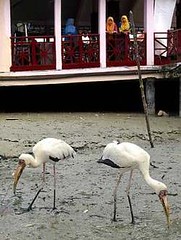 They are starting to find their own food and exploring the surroundings -- it's probably a sign that eight Milky Storks, Mycteria cinerea (pictured), are getting used to their new home at the Kuala Gula Bird Sanctuary. Four pairs were released at the sanctuary to mark World Wetlands Day, a day after they were acquired from Zoo Negara which has about 80 of the birds. Taiping Zoo director Dr Kevin Lazarus said releasing the Milky Storks at Kuala Gula was good for eco-tourism as the birds were used to having people around them.
They are starting to find their own food and exploring the surroundings -- it's probably a sign that eight Milky Storks, Mycteria cinerea (pictured), are getting used to their new home at the Kuala Gula Bird Sanctuary. Four pairs were released at the sanctuary to mark World Wetlands Day, a day after they were acquired from Zoo Negara which has about 80 of the birds. Taiping Zoo director Dr Kevin Lazarus said releasing the Milky Storks at Kuala Gula was good for eco-tourism as the birds were used to having people around them.
Avian Influenza News
Following reports on the occurrence of bird flu in various parts of the world and the recent ban imposed by the UAE on imports of birds and poultry from around the globe, more than 200 bird sellers in Dubai and Sharjah are facing an uncertain future. If the bird flu threat continues to prevail across the globe, businesses worth millions of dirhams will be affected in the UAE, particularly in Dubai and Sharjah, where the average daily earning of a bird seller usually ranges between Dh5,000 and Dh10,000, market sources say. Bird sellers are now left with no stocks as the UAE has imposed a ban on the import of birds from countries like Africa, Pakistan and India. Dubai has about 20 bird shops while in Sharjah, there are around 200 shops.
Streaming Birds
 On BirdNote, for the week of March 5, 2007: Monday, the courtship display of the Montezuma Oropendola, Gymnostinops montezuma; Tuesday, hanging nests of the Montezuma Oropendola; Wednesday, Northern Flicker, Colaptes auratus; Thursday, the lek of the Sage-Grouse, Centrocercus urophasianus; Friday .. St. Patrick's Day .. where are the green birds? BirdNotes transport the listener out of the daily grind with two-minute vignettes that incorporate the rich sounds of birds provided by Cornell University and by other sound recordists, with photographs and written stories that illustrate the interesting -- and in some cases, truly amazing -- abilities of birds. Some of the shows are Pacific Northwest-oriented, but many are of general interest. BirdNote can be heard live, Monday through Friday, 8:58-9:00AM in Western Washington state and Southern British Columbia, Canada, on KPLU radio and now also in North Central Washington state on KOHO radio. All episodes are available in the BirdNote archives, both in written transcript and mp3 formats, along with photographs. Listener ideas and comments are welcomed. [rss].
On BirdNote, for the week of March 5, 2007: Monday, the courtship display of the Montezuma Oropendola, Gymnostinops montezuma; Tuesday, hanging nests of the Montezuma Oropendola; Wednesday, Northern Flicker, Colaptes auratus; Thursday, the lek of the Sage-Grouse, Centrocercus urophasianus; Friday .. St. Patrick's Day .. where are the green birds? BirdNotes transport the listener out of the daily grind with two-minute vignettes that incorporate the rich sounds of birds provided by Cornell University and by other sound recordists, with photographs and written stories that illustrate the interesting -- and in some cases, truly amazing -- abilities of birds. Some of the shows are Pacific Northwest-oriented, but many are of general interest. BirdNote can be heard live, Monday through Friday, 8:58-9:00AM in Western Washington state and Southern British Columbia, Canada, on KPLU radio and now also in North Central Washington state on KOHO radio. All episodes are available in the BirdNote archives, both in written transcript and mp3 formats, along with photographs. Listener ideas and comments are welcomed. [rss].
Miscellaneous Birds
The naturalists at Hilton Pond have always been fascinated by Yellow-bellied Sap-suckers and recently managed to trap one as they discuss in "This Week at Hilton Pond." This capture allowed them to examine closely -- and photograph -- this migrant bird's interesting adaptations from tail to tongue-tip. (You may never have heard of a Sap-lapper, but they think the name is appropriate). Be sure to visit their photo essay about this winter visitor to the Carolinas. This installment is a "double-issue" that covers two weeks and allows them to get caught up after their Costa Rica trip and ensuing illness. Thus, the banding totals cover a 14-day period when they caught lots of birds and had some interesting recaptures--all of which are listed following the photo essay.
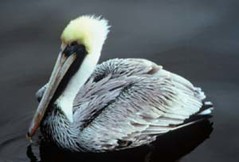 Brown pelicans, Pelecanus occidentalis (pictured, image: USFWS photo by Gary Stotz), are no longer are endangered and should be removed from the nation's list of imperiled species, the U.S. Fish and Wildlife Service said in its first comprehensive review of the birds' status in nearly 30 years. A spokeswoman said the agency has money for the official delisting effort, which is expected to start by year's end. The Fish and Wildlife decision follows a long campaign by the Endangered Species Recovery Council, a La Jolla-based conservation group that said the pelicans had recovered from steep declines in the 1950s and 1960s. "We try to . . . make sure that species get the help they need when they need it," said Bill Everett of Julian, a seabird biologist and founding member of the council. "Let's not spend a lot of time and effort trying to help species like the pelican that don't need it anymore."
Brown pelicans, Pelecanus occidentalis (pictured, image: USFWS photo by Gary Stotz), are no longer are endangered and should be removed from the nation's list of imperiled species, the U.S. Fish and Wildlife Service said in its first comprehensive review of the birds' status in nearly 30 years. A spokeswoman said the agency has money for the official delisting effort, which is expected to start by year's end. The Fish and Wildlife decision follows a long campaign by the Endangered Species Recovery Council, a La Jolla-based conservation group that said the pelicans had recovered from steep declines in the 1950s and 1960s. "We try to . . . make sure that species get the help they need when they need it," said Bill Everett of Julian, a seabird biologist and founding member of the council. "Let's not spend a lot of time and effort trying to help species like the pelican that don't need it anymore."
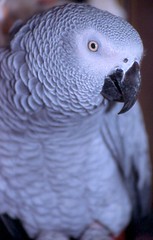 When the owners of the Yuhung Betel Nut Stand in Kaohsiung's Linyuan Township made the decision to spend NT$26,000 (US$788) on an African grey parrot, Psittacus erithacus (pictured, image: Dennis Manoogian), for their store, they were looking for a pet that could become like a child to them. Little did they know, however, that the bird would take such a strong liking to the family business. Customers don't need to ask the price of a pack of betel nut or a can of beer, as Pika has learned to shout them out as soon as they walk through the door. But he is also notorious among customers and neighbors for having learned to swear like a trooper.
When the owners of the Yuhung Betel Nut Stand in Kaohsiung's Linyuan Township made the decision to spend NT$26,000 (US$788) on an African grey parrot, Psittacus erithacus (pictured, image: Dennis Manoogian), for their store, they were looking for a pet that could become like a child to them. Little did they know, however, that the bird would take such a strong liking to the family business. Customers don't need to ask the price of a pack of betel nut or a can of beer, as Pika has learned to shout them out as soon as they walk through the door. But he is also notorious among customers and neighbors for having learned to swear like a trooper.
.
Previous : : Birds in the News : : Next

The Fine Print: Thanks to Leslie, Mike, Biosparite, Ian, Diane, Jeremy, Ellen and Ron for sending story links. Thanks in advance to Ian for catching my typos; as you probably know by now, I put a few typographical errors in these documents just so Ian can find them! The featured image appears here with the kind permission of the photographer, so please contact her if you also wish to purchase this or other of her images. Other images are resized and are either linked from the news story that they accompany or they are credited and linked back to the photographer.
What is the point of Birds in the News? I publish BITN each week because I want to increase people's awareness of the importance of birds in our everyday lives. Birds represent many things to us; beauty, freedom, music, wildness. But everywhere, birds are coming under increasing pressure for their very survival, and by linking to news stories about birds, I hope to make the smallest impression upon the public and the mainstream media, as well as our decision-makers, that birds are an important feature of our everyday lives, that there are so many reasons that we could not do without them.
tags: Birds in the News, ornithology, birds, avian, newsletter

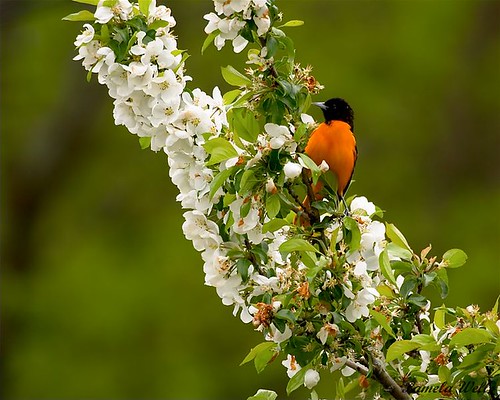
Lovely issue, as always. My dearest friend, who is in Switzerland now but lives ordinarily in Baltimore, is an oriole-fancier of the first caliber, so he'll get a kick out of the gorgeous pic of the Baltimore oriole in today's BITN.
Thank you so much for the gorgeous collection of pics and news, as always.
I actually didn't realize that brown pelicans were still on the list. There seem to be so many of them these days, even on the northern end of their range.
thanks for your kind words and for reading.
incidentally, john, i also was surprised to learn that brown pelicans were still on the endangered species list.